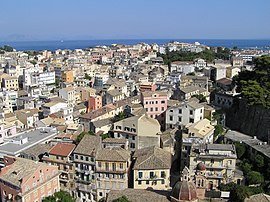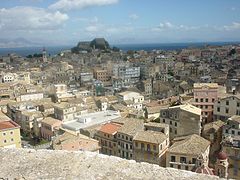Corfu (city)
|
Corfu Κέρκυρα |
||
|---|---|---|

Corfu, as seen from the New Fortress
|
||
|
||
| Coordinates: 39°37′N 19°55′E / 39.617°N 19.917°ECoordinates: 39°37′N 19°55′E / 39.617°N 19.917°E | ||
| Country | Greece | |
| Administrative region | Ionian Islands | |
| Regional unit | Corfu | |
| Municipality | Corfu | |
| • Municipal unit | 41.905 km2 (16.180 sq mi) | |
| Population (2011) | ||
| • Municipal unit | 39,674 | |
| • Municipal unit density | 950/km2 (2,500/sq mi) | |
| Community | ||
| • Population | 32,095 (2011) | |
| Time zone | EET (UTC+2) | |
| • Summer (DST) | EEST (UTC+3) | |
| Postal code | 49100 | |
| Area code(s) | 26610 | |
| Vehicle registration | ΚΥ | |
| Website | www.corfu.gr | |
| Old Town of Corfu | |
|---|---|
| Name as inscribed on the World Heritage List | |
 View of the old town |
|
| Location | Greece |
| Type | Cultural |
| Criteria | iv |
| Reference | 978 |
| UNESCO region | Europe |
| Coordinates | 39°37′N 19°55′E / 39.617°N 19.917°E |
| Inscription history | |
| Inscription | 2007 (31st Session) |
Corfu city or Kerkyra (Greek: Κέρκυρα) is a city and a former municipality on the island of Corfu, Ionian Islands, Greece. Since the 2011 local government reform, it is part of the municipality of Corfu island. It is the capital of the island and of the Corfu regional unit. The city also serves as a capital for the region of the Ionian Islands. The city (population 24,838 in 2011) is a major tourist attraction, and has played an important role since the 8th century. The city has become known since the Middle Ages as Kastropolis (Castle City) because of its two castles. In 2007, the old town of the city was inscribed on the UNESCO World Heritage List. The municipal unit of Corfu city has a land area of 41.905 km2 (16.180 sq mi) and a total population of 39,674 inhabitants. Besides the city of Corfu/Kérkyra, its largest other towns are Kanáli (population 4,086), Potamós (3,840), Kontokáli (1,660), Alepoú (3,149), and Gouviá (838).
The old fortifications of the town, formerly so extensive as to require a force of from 10,000 to 20,000 troops to man them, were in great part thrown down by the English in the 19th century. In several parts of the town may be found houses of the Venetian time, with some traces of past splendour, but they are few compared to the British Neoclassical housing of the 19th and early 20th centuries. The Palace of St. Michael and St. George, built in 1815 by Sir Thomas Maitland (1759–1824; Lord High Commissioner of the Ionian Islands) is a large structure of white Maltese stone. Near Gasturi stands the Pompeian style Achilleion, the palace built for the Empress Elizabeth of Austria, and purchased in 1907 by the German emperor, William II.
...
Wikipedia



